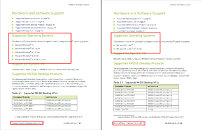- Joined
- Aug 19, 2017
- Messages
- 2,835 (1.03/day)
NVIDIA has today launched its 496.13 game-ready WHQL GeForce graphics driver with many improvements and changes. Starting with the naming, the company has jumped from the 472.12 WHQL version released on September 20th to the 496.xx naming released today. Such a significant increase in version naming is uncommon, and makes us wonder why the company decided to do it, probably in preparation for the Windows 11 branch of their drivers, which uses version 500.
Starting from release 496.13, NVIDIA has also removed support for Windows 8.1, Windows 8 and Windows 7. The last driver to support these operating systems is 472.12. This makes some sense, since between this release and today, Microsoft has launched their Windows 11 operating system. NVIDIA also trimmed more fat by removing support for the Kepler architecture, which was launched in 2012 and included models like GeForce GTX 780 Ti, GTX 780, GTX 770, GTX 760, GT 740, GT 730, GTX 690, GTX 680, GTX 670, GTX 660 Ti, GTX 660, GTX 650 Ti and GTX 630.
Update 15:57 UTC: Added confirmation from NVIDIA


Download NVIDIA GeForce Graphics Drivers 496.13 WHQL.
In addition, this release is unique because it lacks the standard, non-DCH driver version that NVIDIA usually releases, in addition to the DCH driver. Today's release contains the DCH version of the driver only, pushing Microsoft's DCH driver packaging technique as the way forward. Both AMD and Intel have been shipping DCH drivers exclusively for a long time. On NVIDIA, the only significant difference is that the classic driver control panel is gone and that you'll have to download the UWP version through the Microsoft App Store.
We reached out to NVIDIA, who confirmed that R495 is the latest version with support for Windows 7/8.x, and that they'll focus on Windows 10/11 DCH going forward. AMD stopped supporting these operating systems several months ago.
As with any game-ready driver, NVIDIA added support for the latest Back 4 Blood, Baldur's Gate 3, and Crysis Remaster Trilogy, which are October's upcoming games. As we previously covered, this driver also expands NVIDIA Deep Learning Super Sampling (DLSS) support to a few more games, which we have covered in the previous post here. For a full change-log, please see the list at the end of the post.
List of bug fixes and improvements:
Game Ready
GeForce Experience Settings Support
NVIDIA Control Panel > Manage 3D Settings
NvIFR OpenGL support.
Fixed
Windows 10/11 Issues
View at TechPowerUp Main Site
Starting from release 496.13, NVIDIA has also removed support for Windows 8.1, Windows 8 and Windows 7. The last driver to support these operating systems is 472.12. This makes some sense, since between this release and today, Microsoft has launched their Windows 11 operating system. NVIDIA also trimmed more fat by removing support for the Kepler architecture, which was launched in 2012 and included models like GeForce GTX 780 Ti, GTX 780, GTX 770, GTX 760, GT 740, GT 730, GTX 690, GTX 680, GTX 670, GTX 660 Ti, GTX 660, GTX 650 Ti and GTX 630.
Update 15:57 UTC: Added confirmation from NVIDIA


Download NVIDIA GeForce Graphics Drivers 496.13 WHQL.
In addition, this release is unique because it lacks the standard, non-DCH driver version that NVIDIA usually releases, in addition to the DCH driver. Today's release contains the DCH version of the driver only, pushing Microsoft's DCH driver packaging technique as the way forward. Both AMD and Intel have been shipping DCH drivers exclusively for a long time. On NVIDIA, the only significant difference is that the classic driver control panel is gone and that you'll have to download the UWP version through the Microsoft App Store.
We reached out to NVIDIA, who confirmed that R495 is the latest version with support for Windows 7/8.x, and that they'll focus on Windows 10/11 DCH going forward. AMD stopped supporting these operating systems several months ago.
As with any game-ready driver, NVIDIA added support for the latest Back 4 Blood, Baldur's Gate 3, and Crysis Remaster Trilogy, which are October's upcoming games. As we previously covered, this driver also expands NVIDIA Deep Learning Super Sampling (DLSS) support to a few more games, which we have covered in the previous post here. For a full change-log, please see the list at the end of the post.
List of bug fixes and improvements:
Game Ready
- Back 4 Blood
- Crysis Remastered Trilogy
- Baldur's Gate 3
- Rise of the Tomb Raider DLSS
- Shadow of the Tomb Raider DLSS
- Chivalry 2
- Riftbreaker
- Sword and Fairy 7
GeForce Experience Settings Support
- Alan Wake Remastered
- Diablo II: Resurrected
- Far Cry 6
- FIFA 22
- Hot Wheels Unleashed
- Industria
- Kena: Bridge of Spirits
- MIR4
- New World
- Sable
- Severed Steel
- Tales of Arise
- The Legend of Heroes: Hajimari No Kiseki
- Titan Quest: Anniversary Edition
- World War Z: Aftermath
NVIDIA Control Panel > Manage 3D Settings
- Added Shader Cache Size control to set the maximum amount of disk space to use for storing shader compiles.
- Vertical Sync options for Optimus notebook GPUs are now the same as for desktop GPUs.
NvIFR OpenGL support.
- Removed. Release 470 was the last driver branch to support this functionality.
Fixed
- [GeForce RTX 3080]: The system does not boot with two Samsung Odyssey G70A 28" monitors are connected to the GPU. [3359697]
- [GeForce GTX 960]: The primary monitor lost after resume from sleep or shutdown. [3340905]
- [Windows 11]: The screen flashes once after switching to the discrete GPU-only mode in the NVIDIA Control Panel. [3330077]
- [Multiple Apps][Ansel/Freestyle]: Depth of field filter shows blurry characters. [200749545]
- [Notebook]: Vulkan test applications run on the integrated graphics processor instead of the discrete GPU. [200770322]
Windows 10/11 Issues
- [Doom Eternal][HDR][FSR]: Eternal]: Texture across the game darkens and is unplayable after enabling HDR + FSR. [200776916]
- [Rise of the Tomb Raider]: Characters and background disappear and corruption is prominent when Anti-Aliasing is set to SSAA 2X and SSAA 4x. [200777463]
- [Deathloop][HDR]: TDR/corruption occurs in the game with Windows HDR enabled.
- If this issue occurs, toggle the Windows HDR setting.
- [YouTube]: Video playback stutters while scrolling down the YouTube page. [3129705]
- Tom Clancy's The Division 2 may display graphical artifacts. [200754013]
- Sonic & All-Stars Racing Transformed may crash on courses where players drive through water. [3338967]
- [HDR][G-Sync]: Mouse pointer gets stuck after turning on HDR from the Windows Control Panel or after toggling G-Sync from the NVIDIA control panel. [200762998]
- To work around, click the mouse (right or left button). The mouse cursor will be sluggish for a few seconds before returning to normal operation.
- [NVIDIA Control Panel]: After setting the display multiplexer type to "dGPU", the setting is not preserved across a reboot or resume from S4. [200779758]
- [Windows 11]: Display goes blank when video is switched to full-screen with G-Sync enabled. [200778687]
View at TechPowerUp Main Site









